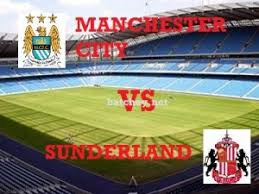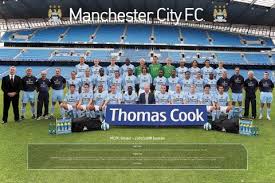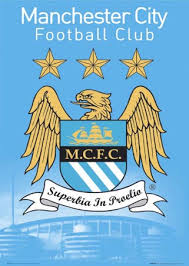 |  |  |  |  |
English Premier League
England
The Barclays English Premier League (EPL), considered as the best in the world.
Manchester City vs Sunderland
Official name Manchester City FC
City Manchester
Founded 1880
Club colors Light-Blue/ White / White
vs.
0 - 0
Sunderland
Official name Sunderland AFC
City Sunderland
Founded 1879
Club colors Red-White vertical striped / Black / Black
Match scheduled:
Date: 19-12-2009
Time:15:00 until 17:00
Week 18 / Round 18 :: Barclays Premier League 2009/2010
After relegation, the club underwent off-the-field upheaval, with new chairman David Bernstein introducing greater fiscal discipline.[20] City were promoted at the first attempt, achieved in dramatic fashion in a play-off against Gillingham. A second successive promotion saw City return to the top division, but this proved to have been a step too far for the recovering club, and in 2001 City were relegated once more. Kevin Keegan arrived as the new manager in the close season, bringing an immediate return to the top division as the club won the 2001–02 Division One championship, breaking club records for the number of points gained and goals scored in a season in the process.[21]
The 2002–03 season was the last at Maine Road, and included a 3–1 derby victory over rivals Manchester United, ending a run of 13 years without a derby win.[22] City also qualified for European competition for the first time in 25 years. In the 2003 close season the club moved to the new City of Manchester Stadium. The first four seasons at the stadium all resulted in mid-table finishes. Former England manager Sven-Göran Eriksson became the club's first manager from overseas when appointed in 2007.[23] After a bright start performances faded in the second half of the season, and Eriksson was sacked in June 2008.[24] Eriksson was replaced by Mark Hughes two days later on 4 June 2008.[25]
In August 2008, the club was purchased by Abu Dhabi United Group. The takeover was immediately followed by a flurry of bids for high profile players; the club broke the British transfer record by signing Brazilian international Robinho from Real Madrid for £32.5 million.[26] City finished tenth, and also reached the quarter-finals of the UEFA Cup. During the summer of 2009 the club took transfer spending to an unprecedented level, with an outlay of over £100 million on players Gareth Barry, Roque Santa Cruz, Kolo Touré, Emmanuel Adebayor, Carlos Tévez and Joleon Lescott.[27]
Manchester City's home colours are sky blue and white. Traditional away kit colours have been either maroon or (from the 1960s) red and black; however, in recent years several different colours have been used. The origins of the club's home colours are unclear, but there is evidence that the club has worn blue since 1892 or earlier. A booklet entitled Famous Football Clubs - Manchester City published in the 1940s indicates that West Gorton (St. Marks) originally played in scarlet and black, and reports dating from 1884 describe the team wearing black jerseys bearing a white cross, showing the club's origins as a church side.[28] The red and black away colours come from former assistant manager Malcolm Allison, who believed that adopting the colours of AC Milan would inspire City to glory.[29]
The current club crest was adopted in 1997, a result of the previous crest being ineligible for registration as a trademark. The badge is based on the arms of the city of Manchester, and consists of a shield in front of a golden eagle. The shield features a ship on its upper half representing the Manchester Ship Canal, and three diagonal stripes in the lower half, for the city's three rivers. The bottom of the badge bears the motto Superbia in Proelio, which translates as Pride in Battle in Latin. Above the eagle and shield are three stars, which are purely decorative.[30]
City have previously worn two other crests on their shirts. The first, introduced in 1970, was based on designs which had been used on official club documentation since the mid-1960s. It consisted of a round badge which used the same shield as the current crest, inside a circle bearing the name of the club. In 1972, this was replaced by a variation which replaced the lower half of the shield with the red rose of Lancashire. On occasions when Manchester City plays in a major cup final, the usual crest is not used; instead shirts bearing a badge of the arms of the City of Manchester are used, as a symbol of pride in representing the city of Manchester at a major event. This practice originates from a time when the players' shirts did not normally bear a badge of any kind, but has continued throughout the history of the club.[31]
Manchester City's current stadium is the City of Manchester Stadium, also known as "Eastlands", a 47,726 capacity stadium situated in East Manchester, leased from Manchester City Council after the 2002 Commonwealth Games. The stadium has been City's home since the end of the 2002–03 season, when the club moved from Maine Road.[56]
Before moving to the stadium, Manchester City spent in excess of £30 million to convert it to football use. The field of play was lowered by several metres, adding an additional tier of seating around the entire pitch. A new North Stand was also built.[57] The inaugural match at the new stadium was a 2–1 win over FC Barcelona in a friendly match.[58]
Manchester City have used several grounds during their history: after playing home matches at five different stadia between 1880 and 1887, the club settled at Hyde Road, its home for 36 years.[59] After a fire destroyed the Main Stand in 1920, the club started to seek a new site and moved to the 84-000 capacity Maine Road three years later. Maine Road, nicknamed the "Wembley of the North" by its designers, hosted the largest-ever crowd at an English club ground when 84,569 attended an FA Cup tie against Stoke City on 3 March 1934.[60] Though Maine Road was redeveloped several times over its 80-year lifespan, by 1995 its capacity was restricted to 32,000, prompting the search for a new ground which culminated in the move to the City of Manchester Stadium in 2003.
Sunderland played in an all blue strip from their formation until 1884,[71] until they adopted a red and white halved strip.[72] They assumed the current strip of red and white stripes in the 1887–88 season.[73] Their badge included a ship, the upper part of the City of Sunderland coat of arms, a black cat, and a football in front of Sunderland's red and white stripes.[74] In 1977 the badge was changed, but still included the ship, football and the background of red and white stripes.[75]
This badge was used until the relocation from Roker Park to the Stadium of Light.[76] To coincide with the move, Sunderland released a new crest divided into four quarters; the upper right and lower left featured their traditional red and white colours, but the ship was omitted. The upper left section features the Penshaw Monument and the lower right section shows the Wearmouth Bridge.[76] A colliery wheel at the top of the crest commemorates County Durham's mining history, and the land the Stadium of Light was built on, formerly the Monkwearmouth Colliery. The crest also contains two lions, the black cats of Sunderland, and a banner displaying the club's motto, Consectatio Excellentiae, which means "In pursuit of excellence".[76]
 |  |  |










